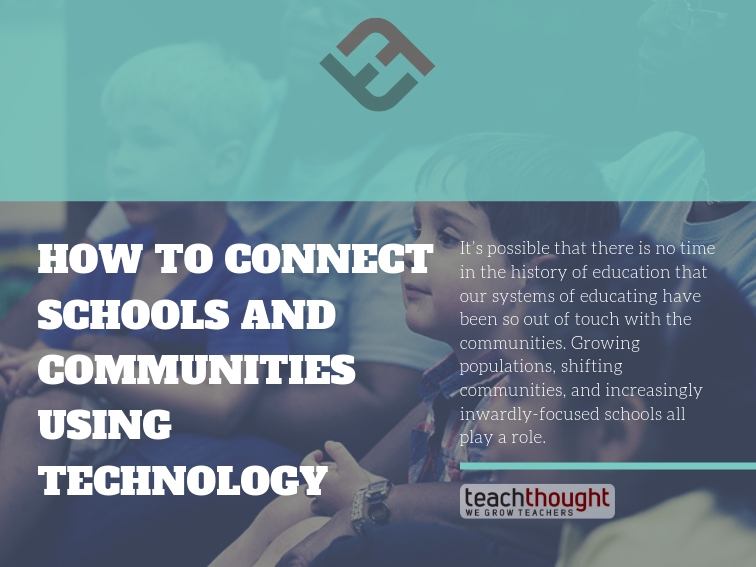
by Terry Heick
It’s possible that there is no time in the history of education that our systems of educating have been so out of touch with the communities. Growing populations, shifting communities, and increasingly inwardly-focused schools all play a role.
In light of the access of modern technology, social media, and new learning models that reconfigure the time and place learning happens, it doesn’t have to be that way. Schools can evolve while simultaneously growing closer to the people they serve.
First, for the purpose of this post let’s think of technology and social media as distinct.
Technology has many forms, but in education, it is most visible in terms of computing hardware and software. The hardware is pretty obvious—phones, wearable technology from Apple and Android, iPads, personal computers, Macs, Chromebooks, graphing calculators, and the like.
The software is a bit more inconspicuous because it’s embedded in the hardware. Here we have fundamental PC software like Microsoft Windows or Mac OS; we have productivity suites like Microsoft Office; we have web browsers like Google Chrome or Safari or Firefox; and we have niche programs like reading assessment tools or educational games, which function like what we’d now consider computer-based apps.
There are also less visible forms of technology that make teaching and learning with technology possible, including electricity (you take it for granted until it doesn’t work) WiFi (imagine your classroom looking like it does behind your television—wires everywhere), the cloud (which enables mobile learning, hardware sharing, flipped classrooms, and other advances), and more. Each of these technology tools is critical in their own way, working together to make whatever we’d define as a ‘modern classroom‘ and ‘modern learning‘ work.
But hidden with this list is one bit of seemingly dated software that can be concept-mapped on its own in a million other directions of possibility. No one gets excited by it, but it still makes the internet go: the web browser.
Although itself just a program that translates html code to visual information, the modern web browser has become a vessel that everything else attaches itself to. For schools looking to connect with communities, it also actuates social media channels like Instagram, twitter, facebook, and pinterest, and allows for the blogging or site updates that keep parents informed.
None of this is new, really. The technology has been there for years. Parents have always been ‘informed’—but of what? That’s where there is potential. What we’re communicating as educators, when, and why.
So what can social media ‘do’?
Solicit mentoring relationships
Whether organized by a district, school, teacher, family, or the student themselves, connecting with potential mentors through social media is compelling because it’s A) Public—transparent and safer than ‘social media’ sounds and B) Because it’s public, it can encourage companies to respond when they may not in private.
Connecting students to the artists, architects, engineers, makers, writers, farmers, cooks, and other ‘roles’ for the purpose of mentoring and apprenticeship is one way to begin to repair the disconnect between schools and communities.
This one is closely related to the idea of ‘mentoring’ in the sense that it connects students with people outside of the classroom from their community. But rather than for the purpose of mentoring, it could be less involved—topical but authentic communication between those leading the community, and those living in it, and social media is the perfect way to make it happen.
Share ‘school work’
Want work to leave the classroom? Use social media to publish it with the world. Worried about privacy? Assign students anonymous codes or avatars to publish under. Used closed communities (Facebook Groups, for example) that, while not fully open, are still school-wide. There are ways.
Curate cultural artifacts and ‘local memory’
Today, museums do the work of ‘curating,’ but that’s a crude way to preserve the cultural artifacts that matter. Why can’t schools do this? And why can’t technology be used to streamline and crowdsource it?
How To Connect Schools And Communities Using Technology
In addition to connecting with the world students live and breathe in, new learning models afforded by technology are also useful in reconnecting with families, neighborhoods, and native places students have affection for.
Flipped Classroom
The flipped classroom is one way to exchange where learning happens—or at least what kind of learning happens where. Here, the roles are reversed: Students are exposed to content at home and practice it at school.
Mobile learning
Mobile learning is a brilliant way to immerse students in native places and landscapes. The challenge here is that education isn’t quite ready for it, but if you can figure it out, the possibilities are extraordinary: Deep integration of learning, place, and people.
Place-based education
See above—learning that is based on place and not an indexed set of nationalized curriculum. Authentic, familiar, and personal.
Project-based learning
Project-based learning can incorporate all of the above—flipped classrooms, place-based learning, mobile learning, and so on. The idea is that teaching and learning are anchored through the process of authentic projects constructed over time. These ‘reason’ or ‘need to know’ for these projects will ideally both start and finish in communities.
Experiential learning/Scenario-based learning
Treat the school like a think tank. Explore and address local community issues. Use social media to connect with families and neighborhoods and businesses and organizations, then use problem-based or scenario-based learning to address them.
Conclusion
Technology, so far, hasn’t healed the disconnect between schools and communities, but that could be because we’re selling it short for what it can do—which might start with not seeing its potential fully. Today, popular uses are sharing grades, missing work, test dates, snow days, and basic school announcements. This isn’t nearly good enough.
Whether you’re talking about hardware, software, social media, or something in between, more than anything else, technology connects. As educators, we just need to be intentional about what we’re connecting, and why.
image attribution flickr user usdepartmentofeducation; how to connect schools and communities

